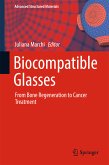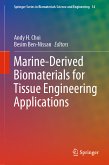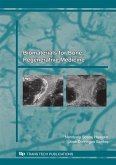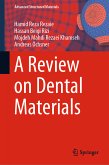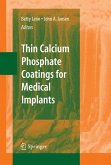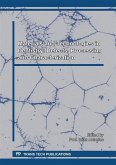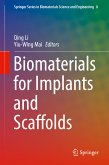Bioceramics, Biomimetic and Other Compatible Materials Features for Medical Applications (eBook, PDF)
Redaktion: Najman, Stevo; Randjelovic, Branislav; Sun, Ziqi; Chen, Po-Yu; Barbeck, Mike; Groth, Thomas; Mitic, Vojislav


Alle Infos zum eBook verschenken

Bioceramics, Biomimetic and Other Compatible Materials Features for Medical Applications (eBook, PDF)
Redaktion: Najman, Stevo; Randjelovic, Branislav; Sun, Ziqi; Chen, Po-Yu; Barbeck, Mike; Groth, Thomas; Mitic, Vojislav
- Format: PDF
- Merkliste
- Auf die Merkliste
- Bewerten Bewerten
- Teilen
- Produkt teilen
- Produkterinnerung
- Produkterinnerung

Hier können Sie sich einloggen

Bitte loggen Sie sich zunächst in Ihr Kundenkonto ein oder registrieren Sie sich bei bücher.de, um das eBook-Abo tolino select nutzen zu können.
This book reports on advanced biomaterials such as bioceramics, hydrogels, biopolymers, nanomaterials, membranes, and other compatible materials for medical applications. It introduces materials as bioactive coatings that utilize or mimic natural mechanisms and structures important for tissue and organ healing and repair. One section of the book is devoted to bone substitutes and osteogenic biomaterials. It also describes biomaterial-cell-tissue interactions, which are of critical importance for various applications in regenerative medicine, orthopedics, and implant functions. The chapters…mehr
- Geräte: PC
- ohne Kopierschutz
- eBook Hilfe
- Größe: 16.5MB
![Biocompatible Glasses (eBook, PDF) Biocompatible Glasses (eBook, PDF)]() Biocompatible Glasses (eBook, PDF)113,95 €
Biocompatible Glasses (eBook, PDF)113,95 €![Marine-Derived Biomaterials for Tissue Engineering Applications (eBook, PDF) Marine-Derived Biomaterials for Tissue Engineering Applications (eBook, PDF)]() Marine-Derived Biomaterials for Tissue Engineering Applications (eBook, PDF)81,95 €
Marine-Derived Biomaterials for Tissue Engineering Applications (eBook, PDF)81,95 €![Biomaterials for Bone, Regenerative Medicine (eBook, PDF) Biomaterials for Bone, Regenerative Medicine (eBook, PDF)]() Nandyala Sooraj HussainBiomaterials for Bone, Regenerative Medicine (eBook, PDF)92,95 €
Nandyala Sooraj HussainBiomaterials for Bone, Regenerative Medicine (eBook, PDF)92,95 €![A Review on Dental Materials (eBook, PDF) A Review on Dental Materials (eBook, PDF)]() Hamid Reza RezaieA Review on Dental Materials (eBook, PDF)113,95 €
Hamid Reza RezaieA Review on Dental Materials (eBook, PDF)113,95 €![Thin Calcium Phosphate Coatings for Medical Implants (eBook, PDF) Thin Calcium Phosphate Coatings for Medical Implants (eBook, PDF)]() Thin Calcium Phosphate Coatings for Medical Implants (eBook, PDF)73,95 €
Thin Calcium Phosphate Coatings for Medical Implants (eBook, PDF)73,95 €![Materials and Technologies in Dentistry: Defects, Processing and Characterization (eBook, PDF) Materials and Technologies in Dentistry: Defects, Processing and Characterization (eBook, PDF)]() Materials and Technologies in Dentistry: Defects, Processing and Characterization (eBook, PDF)115,95 €
Materials and Technologies in Dentistry: Defects, Processing and Characterization (eBook, PDF)115,95 €![Biomaterials for Implants and Scaffolds (eBook, PDF) Biomaterials for Implants and Scaffolds (eBook, PDF)]() Biomaterials for Implants and Scaffolds (eBook, PDF)113,95 €
Biomaterials for Implants and Scaffolds (eBook, PDF)113,95 €-
-
-
Dieser Download kann aus rechtlichen Gründen nur mit Rechnungsadresse in A, B, BG, CY, CZ, D, DK, EW, E, FIN, F, GR, HR, H, IRL, I, LT, L, LR, M, NL, PL, P, R, S, SLO, SK ausgeliefert werden.
- Produktdetails
- Verlag: Springer International Publishing
- Seitenzahl: 405
- Erscheinungstermin: 1. Januar 2023
- Englisch
- ISBN-13: 9783031172694
- Artikelnr.: 67152127
- Verlag: Springer International Publishing
- Seitenzahl: 405
- Erscheinungstermin: 1. Januar 2023
- Englisch
- ISBN-13: 9783031172694
- Artikelnr.: 67152127
- Herstellerkennzeichnung Die Herstellerinformationen sind derzeit nicht verfügbar.

